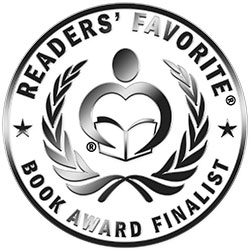
 This author participates in the Readers' Favorite Free Book Program, which is open to all readers and is completely free. The author will provide you with a free copy of their book in exchange for an honest review. You and the author will discuss what sites you will post your review to and what kind of copy of the book you would like to receive (eBook, PDF, Word, paperback, etc.). To begin, click the purple email icon to send this author a private email.
This author participates in the Readers' Favorite Free Book Program, which is open to all readers and is completely free. The author will provide you with a free copy of their book in exchange for an honest review. You and the author will discuss what sites you will post your review to and what kind of copy of the book you would like to receive (eBook, PDF, Word, paperback, etc.). To begin, click the purple email icon to send this author a private email.
![]() This author participates in the Readers' Favorite Book Donation Program, which was created to help nonprofit and charitable organizations (schools, libraries, convalescent homes, soldier donation programs, etc.) by providing them with free books and to help authors garner more exposure for their work. This author is willing to donate free copies of their book in exchange for reviews (if circumstances allow) and the knowledge that their book is being read and enjoyed. To begin, click the purple email icon to send this author a private email. Be sure to tell the author who you are, what organization you are with, how many books you need, how they will be used, and the number of reviews, if any, you would be able to provide.
This author participates in the Readers' Favorite Book Donation Program, which was created to help nonprofit and charitable organizations (schools, libraries, convalescent homes, soldier donation programs, etc.) by providing them with free books and to help authors garner more exposure for their work. This author is willing to donate free copies of their book in exchange for reviews (if circumstances allow) and the knowledge that their book is being read and enjoyed. To begin, click the purple email icon to send this author a private email. Be sure to tell the author who you are, what organization you are with, how many books you need, how they will be used, and the number of reviews, if any, you would be able to provide.

Reviewed by Maria Beltran for Readers' Favorite
Jane Guttman’s Kids in Jail: A Portrait of Life Without Mercy is a forceful narrative about one of the most disturbing social issues facing our society today; the splintered state of our juvenile justice system. It exposes the devastating stories of thirteen children who are behind bars in a series of poignant poems that reveal their fears, shame and hopes. Allie has been in jail since childhood. Tough, bitter and smart, she screams for love and understanding as she continues her days in captivity, dreaming of rising from the ruin that is her young troubled life. Rashad has been out of jail since three days. If he finishes high school, he will be the first one in the family to do so. Dirt poor and struggling, his mother is unable to nurture and guide him.
Jane Guttman’s choice of poetry to tell the stories of these troubled young people makes her book even more compelling. Verse after verse, one can hear their screams and feel their fears. “Heard about this kid that was raped/when he was a kid/a little kid/ like about age 6,” says one poem. “Show respect/Follow the rules/Don’t want to be the target/of some staff’s hit,” goes another. In moving metaphors, there is also a small hint of hope as in the lines: “Know this kid who has 16 relatives in prison/She told us in class and asked/the teacher how she could have a chance/Teacher said “You do.”
Most of these kids do not have many choices because they are either abandoned by their own parents or live in troubled foster homes and dangerous neighborhoods. Some are lured by the wrong friends and blinded by drug use. And they all end up in jail where a career in crime awaits them, unless sweeping changes are done to the juvenile justice system. Kids in Jail: A Portrait of Life Without Mercy is as eloquent as it is heartrending!